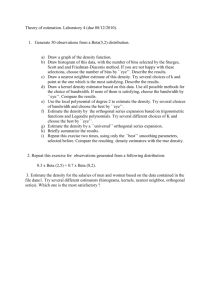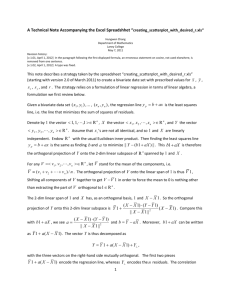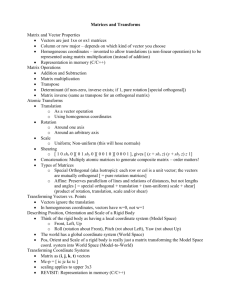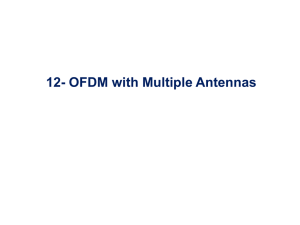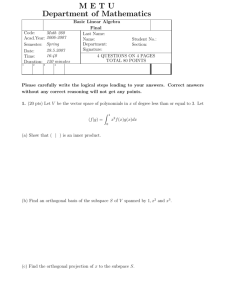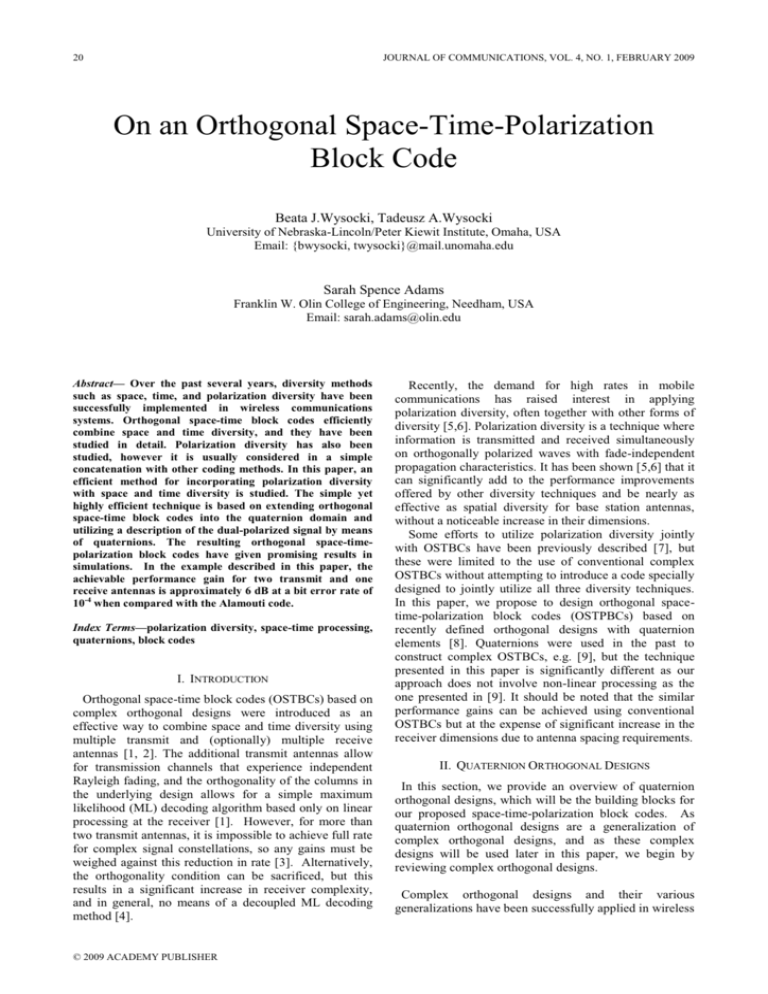
20
JOURNAL OF COMMUNICATIONS, VOL. 4, NO. 1, FEBRUARY 2009
On an Orthogonal Space-Time-Polarization
Block Code
Beata J.Wysocki, Tadeusz A.Wysocki
University of Nebraska-Lincoln/Peter Kiewit Institute, Omaha, USA
Email: {bwysocki, twysocki}@mail.unomaha.edu
Sarah Spence Adams
Franklin W. Olin College of Engineering, Needham, USA
Email: sarah.adams@olin.edu
Abstract² Over the past several years, diversity methods
such as space, time, and polarization diversity have been
successfully implemented in wireless communications
systems. Orthogonal space-time block codes efficiently
combine space and time diversity, and they have been
studied in detail. Polarization diversity has also been
studied, however it is usually considered in a simple
concatenation with other coding methods. In this paper, an
efficient method for incorporating polarization diversity
with space and time diversity is studied. The simple yet
highly efficient technique is based on extending orthogonal
space-time block codes into the quaternion domain and
utilizing a description of the dual-polarized signal by means
of quaternions. The resulting orthogonal space-timepolarization block codes have given promising results in
simulations. In the example described in this paper, the
achievable performance gain for two transmit and one
receive antennas is approximately 6 dB at a bit error rate of
10-4 when compared with the Alamouti code.
Index Terms²polarization diversity, space-time processing,
quaternions, block codes
I. INTRODUCTION
Orthogonal space-time block codes (OSTBCs) based on
complex orthogonal designs were introduced as an
effective way to combine space and time diversity using
multiple transmit and (optionally) multiple receive
antennas [1, 2]. The additional transmit antennas allow
for transmission channels that experience independent
Rayleigh fading, and the orthogonality of the columns in
the underlying design allows for a simple maximum
likelihood (ML) decoding algorithm based only on linear
processing at the receiver [1]. However, for more than
two transmit antennas, it is impossible to achieve full rate
for complex signal constellations, so any gains must be
weighed against this reduction in rate [3]. Alternatively,
the orthogonality condition can be sacrificed, but this
results in a significant increase in receiver complexity,
and in general, no means of a decoupled ML decoding
method [4].
© 2009 ACADEMY PUBLISHER
Recently, the demand for high rates in mobile
communications has raised interest in applying
polarization diversity, often together with other forms of
diversity [5,6]. Polarization diversity is a technique where
information is transmitted and received simultaneously
on orthogonally polarized waves with fade-independent
propagation characteristics. It has been shown [5,6] that it
can significantly add to the performance improvements
offered by other diversity techniques and be nearly as
effective as spatial diversity for base station antennas,
without a noticeable increase in their dimensions.
Some efforts to utilize polarization diversity jointly
with OSTBCs have been previously described [7], but
these were limited to the use of conventional complex
OSTBCs without attempting to introduce a code specially
designed to jointly utilize all three diversity techniques.
In this paper, we propose to design orthogonal spacetime-polarization block codes (OSTPBCs) based on
recently defined orthogonal designs with quaternion
elements [8]. Quaternions were used in the past to
construct complex OSTBCs, e.g. [9], but the technique
presented in this paper is significantly different as our
approach does not involve non-linear processing as the
one presented in [9]. It should be noted that the similar
performance gains can be achieved using conventional
OSTBCs but at the expense of significant increase in the
receiver dimensions due to antenna spacing requirements.
II. QUATERNION ORTHOGONAL DESIGNS
In this section, we provide an overview of quaternion
orthogonal designs, which will be the building blocks for
our proposed space-time-polarization block codes. As
quaternion orthogonal designs are a generalization of
complex orthogonal designs, and as these complex
designs will be used later in this paper, we begin by
reviewing complex orthogonal designs.
Complex orthogonal designs and their various
generalizations have been successfully applied in wireless
JOURNAL OF COMMUNICATIONS, VOL. 4, NO. 1, FEBRUARY 2009
communications systems. The following generalization
provided by Tarokh et al [1] has been particularly useful:
Defn 1: A generalized complex orthogonal design G is a
p x n matrix whose entries are from {0, z1, z2«, zu, z1*,
z2«, zu*} including possible multiplications by the
complex number i, such that
u
GHG
Ȝ l | zl |2 I n
l 1
More recently, orthogonal designs over the quaternion
domain have been studied [8]. The noncommutative
quaternions, invented by Hamilton in 1843, can be
viewed as a generalization of the complex numbers. The
quaternion elements Q = {±1, ±i, ±j, ±k} satisfy i2 = j2 =
k2 = ijk = ± 1. Given a quaternion variable s =
x1 y1i x2 j y2 k where x1, y1, x2, y2 are real variables,
the quaternion conjugate sQ is defined analogously to the
complex conjugate so that
( x1
x1
y1i
III. QUATERNIONIC REPRESENTATION OF DUAL
POLARIZED SIGNALS
Quaternions are very well suited to describe rotations and
sequences of rotations and were used by Isayeva and
Sarytchev [12] to describe dual-polarized radio signals,
whereby two complex signals are rotated one against
another by 90 degrees on the polarization plane. Using
that approach, two complex signals
z1
where H indicates the Hermitian transpose, In is the n × n
identity matrix, and Ȝl is the positive number of times the
variable zl appears in each column.
sQ
21
x2 j
y1i x2 j
y2 k )Q
y2 k
y1i and
z2
x2
y2 i
(2)
being orthogonal to each other on a polarization plane
form a quaternion number
s z1 z 2 j x1 y1i x2 j y2 k
Rx
Tx
h11
Tx
.
x1
h21
h12
h22
Rx
(1)
We note that for a complex variable z, we have zj jz* ,
where z* is the complex conjugate of z. It follows that sQs
= |s|2 = |z1|2 + |z2|2 = x12 + y12 + x22 + y22 . For matrices of
quaternion numbers or variables, the quaternion
transform is analogous to the Hermitian transform for
complex matrices: For a quaternion matrix S = [slm] , we
define the quaternion transform as SQ = [sQml]. This leads
to the following definition of quaternion orthogonal
designs [8], which is clearly a generalization of Defn 1:
Fig. 1. Schematic diagram of a channel utilizing dual-polarized antennas
and its model (below) with the horizontally and vertically polarized
antennas considered separately; the channel gains are complex numbers.
A rotation sij of the signal s on a polarization plane by
an angle of ij can be simply represented in the quaternion
notation as:
s
se j
( z1
Defn 2: A quaternion orthogonal design (QOD) D on
quaternion variables s1, s2 « su is a p × n matrix with
entries from the set
including possible multiplications on the left and/or right
by quaternion elements q Q satisfying
( z1
z 2 j )e j
z 2 j )[cos( )
.
(3)
j sin( )]
Similarly, any change to the polarization bases, e.g.,
due to differences between transmit and receive antenna
alignments, can be easily represented in the quaternion
notation, as long as the polarization bases are orthogonal
[12].
u
DQ D
l
| sl | 2 I n ,
IV. DIVERSITY GAIN IN DUAL-POLARIZED CHANNELS
l 1
where Ȝl is the positive number of times the variable sl
appears in each column.
Several construction methods for obtaining QODs over
quaternion variables, as well as for QODs over real and
complex variables, have been introduced [8, 10]. One of
these construction methods will be utilized below in
Section V. Previously, the application of QODs as
orthogonal space-time-polarization block codes has been
briefly described [8], and this current paper expands upon
WKH DXWKRUV¶ UHFHQW FRQIHUHQFH SDSHU on this application
[11].
© 2009 ACADEMY PUBLISHER
The mechanism of a diversity gain for OSTBCs relies
on providing extra transmission channels that experience
independent Rayleigh fading through the use of
additional transmit antennas [13]. This can be also
achieved using dual-polarized antennas (e.g., antennas
having both vertical and horizontal polarizations). Even a
case involving just 1 transmit and 1 receive antenna
results in 4 sub-channels, each characterized by its own
complex gain (see Fig. 1), much the same as in case of a
2-input 2-output MIMO system [14].
Mathematically, the channel between transmitter and
receiver is in such a case described by a channel gain
matrix H:
22
JOURNAL OF COMMUNICATIONS, VOL. 4, NO. 1, FEBRUARY 2009
h11 h12
,
h21 h22
H
(4)
where h11 and h22 are complex channel gains for signals
received with the same polarization as they were
transmitted, and h12 and h21 are complex channel gains for
a cross-polar scatter, i.e., signals received with different
polarization from that at which it was transmitted due to
scatter, reflections and polarization twist between the
transmit and receive antennas.
Introducing representation of a quaternion variable s =
z1 + z2j as s = [z1, z2], transmission of the signal through a
channel between a dual-polarized transmit and a dualTx1
s1
r
H (2)
H
(N)
Tx N
sN
where s1, s2«sN are the input signal symbols applied to
WKHWUDQVPLWDQWHQQDV7[7[«7[1
,
,
(m)
and matrices H ; m «N, are all of the structure
defined by Eqn. (4).
Orthogonal space-time block codes (OSTBCs) jointly
utilize space and time diversities and allow for a
decoupled maximum likelihood (ML) decoding at the
receiver [1]. To jointly utilize space, time, and
polarization diversities, we propose here orthogonal
space-time-polarization block codes (OSTPBCs). Such
codes can be derived from the quaternion orthogonal
designs defined in Section II.
Of the various techniques recently presented to
construct QODs [8, 10], one of the simplest techniques is
based on symmetric-paired designs: Two complex
orthogonal designs A and B are said to be symmetricpaired designs if ABH is symmetric and/or AHB is
symmetric [8]. This condition is similar to that required
of complex amicable designs [8]. It has been shown [8]
that if the complex orthogonal designs A and B are
symmetric-paired designs, then
R x1
Tx 2
A + Bj
Fig. 2. A transmission system utilizing N dual-polarized transmit
DQWHQQDV7[«7[1DQGDVLQJOHUHFHLYHGXDO-polarized antenna.
polarized receive antennas can be modeled as a product
sH. Hence the received quaternion signal r is given by:
r
(7)
is a QOD.
Consider now two CODs of order 2
and
sH n
[ z1 , z 2 ]H [n1 , n 2 ]
[ z1 h11
z 2 h21 , z1 h12
( z1 h11
z 2 h21 ) ( z1 h12
,
z 2 h22 ] [n1 , n 2 ]
z 2 h22 ) j n1
(5)
,
For example, for the scenario considered there, the
received signal r can be modeled as a quaternionic
variable given by:
(8)
which are two Alamouti [11] OSTBCs, one of them (B)
having switched columns. Since we have
n2 j
where n1, n2 are complex additive White Gaussian noises
being the independent identically distributed (i.i.d.) zeromean two dimensional Gaussian random variables with
identical variance per dimension. The exact value of the
variance depends on the value of a signal-to-noise ratio
(SNR) at the receiver.
This consideration can be extended to the scenarios
with multiple transmit and/or receive antennas [8], like
the scenario considered in Fig. 2.
© 2009 ACADEMY PUBLISHER
(6)
V. ORTHOGONAL SPACE-T IME-POLARIZATION BLOCK
CODES
H (1)
s2
,
(9)
then AHB is clearly symmetric and the design
Q1
A Bj
z1 z 2 j
z 2* z1* j
z2
z1*
z1 j
z 2* j
(10)
is a QOD. Introducing now a quaternion variable
Q1 can be expressed as:
,
(11)
JOURNAL OF COMMUNICATIONS, VOL. 4, NO. 1, FEBRUARY 2009
and can be considered as a QOD on the one quaternion
variable a. The orthogonality can be easily checked, as
.
23
finding a pair of elements z1 and z2 of the complex signal
constellation Z that minimizes the following metric:
(12)
R Q1
Because for two quaternion variables b and c [7]:
H (1)
H( 2)
| r1 z1h11(1)
| r2
Eqn. (12) can be expanded to:
.
z2*h11(1)
2 Re{r1Q z1 ( g 1
.
Substituting the latest results into (14) and utilizing the
principles of the arithmetic of quaternions, yields:
min | z2 |2 (| g1 |2
(15)
Using the same notation as in (5), Q1 can be expressed
as:
Q1
z1
z 2*
z2
z1*
z2
z1*
z1
z 2*
(16)
where odd columns represent signals transmitted through
one polarization and even columns represent signals
transmitted through the polarization orthogonal to the
first one.
For a single receive dual-polarized antenna, the
channels between dual-polarized transmit antennas Tx1
and Tx2, and the dual-polarized receive antenna Rx1 are
described by their own channel gain matrices,
(1)
( 2)
H (1) [hmn
]2 2 and H ( 2) [hmn
]2 2 , respectively. The
received signal vector R is given by
Q1
H (1)
H ( 2)
n11 n12
n21 n22
(1)
( 2)
z1h11(1) z2 h21
z2 h11( 2) z1h21
* (1)
* (1)
* ( 2)
* ( 2)
z2 h11 z1 h21 z1 h11 z2 h21
(1)
( 2)
z1h12(1) z2 h22
z2 h12( 2) z1h22
j
* (1)
* (1)
* ( 2)
* ( 2)
z2 h12 z1 h22 z1 h12 z2 h22
(17)
n11
n21
n12
j
n22
where nml; m, l = 1, 2 represent complex noises being the
independent identically distributed (i.i.d.) zero-mean two
dimensional Gaussian random variables with identical
variance per dimension.
Assuming perfect channel knowledge at the receiver,
i.e. assuming that matrices H(1) and H(2) are known and
constant for some reasonable time, as in the case of slow
or block fading channels [14], the ML decoding means
© 2009 ACADEMY PUBLISHER
z1*h11( 2 )
( 2)
z2*h21
( 2)
z2*h22
j |2
| g 3 |2
| g 4 |2 )
g 2 j ) r2Q z1* ( g 3
(19)
g 4 j )}
and for z2 it is:
z2 Z
R
| g 2 |2
z1 Z
and
(1)
z1*h21
(18)
where r1 and r2 are the elements of the receive vector R.
Utilizing the principles of quaternionic arithmetic given
in Section II, the decoding rule can be simplified and
proven to be decoupled. The resulting decoding statistics
for z1 is:
min | z1 | 2 (| g 1 | 2
Hence
( 2)
z1h21
(1)
z2*h12(1) j z1*h22
j z1*h12( 2) j
(14)
From the definition of a quaternion, we have:
z2 h11( 2)
(1)
( 2)
z1h12(1) j z2 h22
j z2 h12( 2) j z1h22
j |2
(13)
.
(1)
z2 h21
| g 2 |2
2 Re{r1Q z2 ( g3
| g3 |2
| g 4 |2 )
(20)
g 4 j ) r2Q z2* ( g1 g 2 j )}
where
g1
h11(1)
h21( 2) ,
g2
h12(1)
h22( 2 ) ,
g3
h21(1)
h11( 2) ,
g4
h22(1)
h12( 2 )
VI. SIMULATION RESULTS
To assess performance gain that can be achieved using
the developed OSTPBC for 2 transmit and a single
receive dual-polarized antennas, the system was
implemented using MATLAB. The following conditions
were assumed:
7KH 436. ^ʌ ʌ ʌ ʌ` VLJQDO
constellation was applied, and the code based on Q1
was used (OSTPBC).
Total transmitted power in both polarizations and
through both antennas was equal to 1 and equally
distributed per antenna and per polarization.
Channel coefficient matrices, H(1) and H(2) were
assumed known at the receiver and kept constant
for 1024 data bits (the block fading scenario).
In the dynamic indoor scenario, variances of
channel coefficients can change randomly due to
changing scattering conditions. Hence we only
assumed that the sum of variances of all the
coefficients was equal to 1 and that the variance of
real and imaginary part of a particular coefficient
was identical. The variances were then drawn
randomly, every time the new set of coefficients
was drawn.
The channel coefficients were generated as random
complex Gaussian i.i.d. variables.
The additive noise was assumed to be AWGN
added uniformly for each polarization and each
24
JOURNAL OF COMMUNICATIONS, VOL. 4, NO. 1, FEBRUARY 2009
real/imaginary component (a quaternion zero-mean
Gaussian variable).
possibilities for increasing the total diversity gain and
improving system performance in harsh radio
environments without increasing dimensions of antenna
system. In the paper, we considered a very simple
channel model. More realistic channel models taking to
account possibility of correlation between polarizations
need to be considered as well. Future research efforts will
be devoted to designing maximum rate, full diversity
OSTPBCs for two and more transmit antennas.
REFERENCES
[1]
[2]
[3]
Fig. 3. Bit-error-rate (BER) performance of the developed scheme
(OSTPBC) combined with QPSK modulation in a slow flat Rayleigh
fading channel experiencing random cross-polar scatter compared
with the $ODPRXWL¶V VFKHPH DQG D VLQJOH WUDQVPLWVLQJOH UHFHLYH
antenna system.
To compare the performance achieved, we also
simulated a single polarization, single transmit ± single
receive system experiencing slow Rayleigh fading, and a
single polarization Alamouti systems with two transmit
and one receive (2Tx/1Rx) antennas and with 4Tx/2Rx
configuration [2]. The simulation parameters were
adjusted for those systems to ensure consistency of the
conditions. The simulation results are presented in Fig. 3,
where we have also drawn the curve representing
performance of QPSK in the AWGN channel. It is clearly
visible that the proposed OSTPBC performs very robustly
in a realistic indoor environment and significantly
outperforms the 2Tx/1Rx Alamouti system and performs
exactly the same as 4Tx/2Rx Alamouti scheme. This is
due to the fact that the proposed OSTPBC is equivalent to
the 4Tx/2Rx Alamouti scheme. The benefit of the
proposed scheme follows from the fact that its physical
dimensions are similar to the system using 2Tx/1Rx
Alamouti OSTBC with the performance of the 4Tx/2Rx
code. For a fair comparison, the average total received
power in all systems before adding noise was set to 1, and
we used the same SNR normalization as used in [2].
In addition, the 2Tx/1Rx Alamouti scheme is
susceptible to the cross-polar scatter unless antennas
capturing energy from both polarizations are used with
the dimensions fully comparable to antenna system of the
proposed scheme.
[4]
[5]
[6]
[7]
[8]
[9]
[10]
[11]
[12]
[13]
[14]
97DURNK +-DIDUNKDQL $5&DOGHUEDQN ³6SDFH-Time Block
&RGHVIURP2UWKRJRQDO'HVLJQV´IEEE Trans. on Info. Th,, Vol.
45, No. 5, pp. 1456-1467, 1999.
6 $ODPRXWL ³$ 6LPSOH 7UDQVPLW 'LYHUVLW\ 7HFKQLTXH IRU
:LUHOHVV &RPPXQLFDWLRQV´ IEEE J. on Selected Areas in
Communications, Vol. 16, No. 8, pp. 1451-1458, 1998.
X.-%/LDQJ DQG ;* ;LD ³2Q WKH 1RQH[LVWHQFH RI 5DWH-One
Generalized Complex Orthogonal 'HVLJQV´ IEEE Trans.
Information Theory, Vol.49, no.11, pp.2984-2988, 2003.
L.A. Dalton, DQG&1 *HRUJKLDGHV³$ )XOO-Rate, Full-Diversity
Four-Antenna Quasi-Orthogonal Space-7LPH %ORFN &RGH´ IEEE
Trans. Wireless Commun., Vol. 4, No. 2, pp. 363-366, 2005.
&%'LHWULFK .'LHW]H -51HDO\ DQG :/6WXW]PDQ ³6SDWLDO
Polarization, and Pattern Diversity for Wireless Handheld
7HUPLQDOV´IEEE Trans. Antennas Propagat., Vol. 49, pp.1271 ±
1281, 2001.
R.U.Nabar, H.Bölcskei, V.Erceg, D.Gesbert, A.J.Paulraj:
³Performance of Multiantenna Signaling Techniques in the
3UHVHQFH RI 3RODUL]DWLRQ 'LYHUVLW\´ IEEE Trans. Signal
Processing, Vol. 50, pp. 2553-2562, 2002.
100XUDG '&DUVHQDW DQG %-HFNR ³6SDFH-Polarization
Diversity for a 2x2 MIMO Using Space Time Block Codes´
IEEE/ACES Int. Conf. Wireless Communications and Applied
Computational Electromagnetics, 3-7 April 2005, pp.482-485.
J.Seberry, K.Finlayson, S. Spence Adams, T.A Wysocki, T.Xia,
DQG %-:\VRFNL ³7KH 7KHRU\ RI 4XDWHUQLRQ 2UWKRJRQDO
'HVLJQV´ IEEE Trans. on Signal Processing, Vol.56, No.1,
pp.256-265.
A.R. Calderbank, S. Das, N. Al-'KDKLU DQG 61 'LJJDYL ³$
Novel Full-Rate Full-Diversity Orthogonal STBC with
$SSOLFDWLRQWR:L0$;³IEEE VTC Fall 2005, CDROM.
S. S. Adams, J. Seberry, N. Karst, J. Pollack, T. Wysocki:
³4XDWHUQLRQ 2UWKRJRQDO 'HVLJQV IURP &RPSOH[ &RPSDQLRQ
'HVLJQV´Linear Algebra and its Applications, Vol. 428, Issue 4,
pp. 1056-1071, Feb 2008.
B. J Wysocki, T. Wysocki, J. Seberry, S. S. Adams, H. Sharif: "A
Simple Orthogonal Space-Time-Polarization Block Code", 66th
IEEE Vehicular Technology Conference, Sept. 2007
20,VDHYD DQG 9$6DU\WFKHY ³4XDWHUQLRQ 3UHVHQWDWLRQV
3RODUL]DWLRQ 6WDWH´ Proc. 2nd IEEE Topical Symposium of
Combined Optical-Microwave Earth and Atmosphere Sensing,
Atlanta, GA USA, 3-6 April 1995, pp.195-196.
*-)RVFKLQL DQG 0-*DQV ³2Q /LPLWV RI :LUHOHVV
Communication in Fading Environment when using Multiple
$QWHQQDV´ Wireless Personal Communications, Vol.6, no.3,
pp.311-335, 1998.
S.Haykin, and M.Moher, Modern Wireless Communications,
Pearson Prentice Hall, Upper Saddle River, 2005.
VII. CONCLUSIONS
In this paper, we proposed a method to jointly utilize
space, time, and polarization diversities by introducing
the concept of orthogonal space-time-polarization block
codes (OSTPBCs). The given example performs very
well in an environment characterized by block or slow
Rayleigh fading combined with slowly changing crosspolar scatter. The use of quaternionic arithmetic to design
OSTPBCs and to perform decoding opens new
© 2009 ACADEMY PUBLISHER
Beata Joanna Wysocki, Ph.D. received the M.Eng.
degree in electrical engineering from theWarsaw
University of Technology,Warsaw, Poland, in 199 and
the
Ph.D.
degree
from
the
Australian
Telecommunications Research Institute at Curtin
University of Technology, Perth, Australia, in 2000. Her
dissertation was on signal formats for code-division
multiple-access wireless networks.
JOURNAL OF COMMUNICATIONS, VOL. 4, NO. 1, FEBRUARY 2009
From October 1999 to January 2008, she was a Research
Fellow with the Telecommunications & Information
Technology Research Institute at the University
Wollongong, New South Wales, Australia. Since
February 2008 she has been with the Computer and
Electronics Engineering Department of the University of
Nebraska ± Lincoln as a Research Assistant Professor.
Her research interests include space±time signal
processing, sequence design for direct sequence (DS)
code-division multiple-access (CDMA) data networks,
and
optimization
of
ultra-wide-band
(UWB)
communication systems.
Tadeusz Antoni Wysocki, D.Sc., PhD. received the
M.Sc.Eng. degree with the highest distinction in
telecommunications from the Academy of Technology
and Agriculture, Bydgoszcz, Poland, in 1981 and the
Ph.D. degree and the D.Sc. (Habilitation) degree in
telecommunications from the Warsaw University of
Technology, Warsaw, Poland, in 1984 and 1990. In 1992,
he moved to a position at Edith Cowan University, Perth,
Western Australia. In 1993, he was with the University of
Hagen, Germany, within the framework of Alexander von
Humboldt Research Fellowship. In December 1998, he
became an Associate Professor, within the School of
Electrical,
Computer
and
Telecommunications
Engineering, at the University of Wollongong, New
SouthWales, Australia. Since fall 2007, he has been with
the University of Nebraska²Lincoln as Professor of
Computer and Electronics Engineering at the Peter
Kiewit Institute, Omaha, NE. The main areas of his
research interests include space±time signal processing,
diversity combining, indoor propagation of microwaves,
as well as protocols for wireless ad hoc networks.
Sarah Spence Adams, Ph.D. received the B.S. degree in
mathematics (summa cum laude) from the University of
Richmond, VA and the M.S. and Ph.D. degrees in
mathematics from Cornell University, Ithaca, NY, where
she was also a member of the Wireless Intelligent
Systems Laboratory in the Department of Electrical and
Computer Engineering. Previous experience includes
appointments at the Institute for Defense Analyses,
Center for Communications Research and the National
Security Agency. She is currently an Associate Professor
at the Franklin W. Olin College of Engineering in
Needham, MA.
Dr. Adams is a member of the Institute for Electrical and
Electronics Engineers, the American Mathematics
Society, and the Association for Women in Mathematics.
Within the Mathematical Association of America (MAA),
she serves on committees involving undergraduate
programs and research, and she is an ExxonMobil Fellow
LQ0$$¶V3URMHFW1([71HZ([SHULHQFHVLQ7HDFKLQJ
© 2009 ACADEMY PUBLISHER
25


